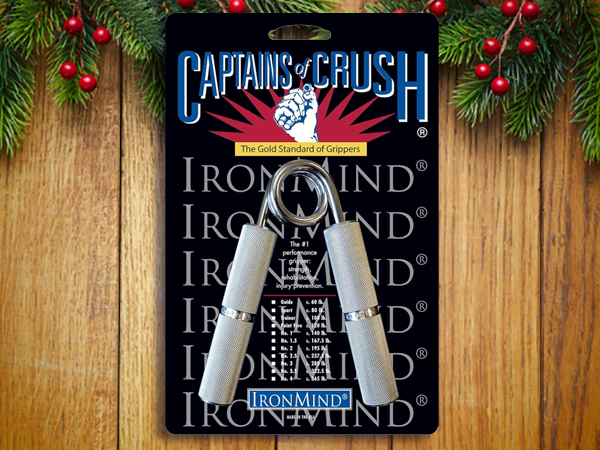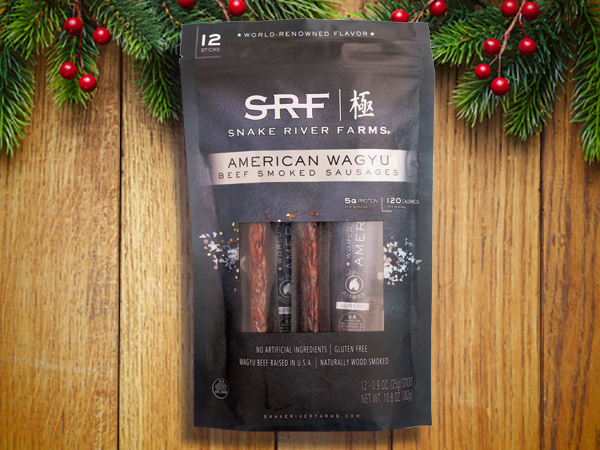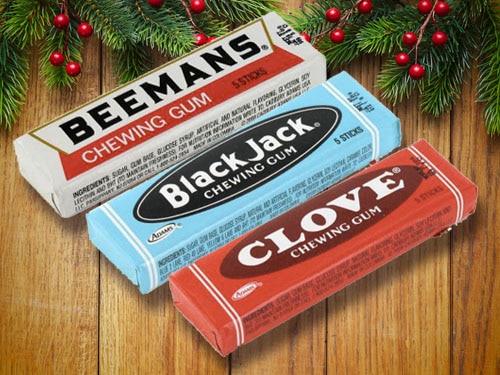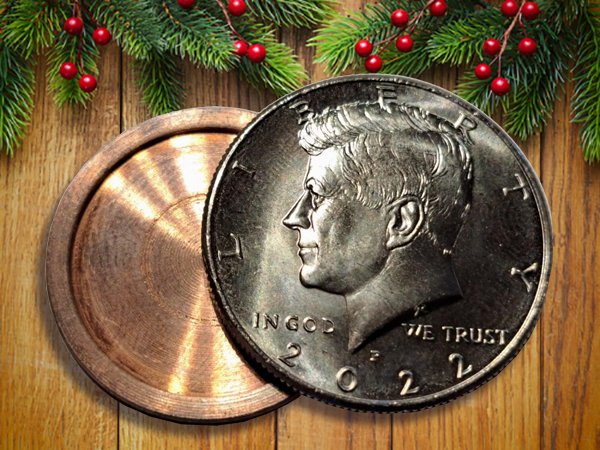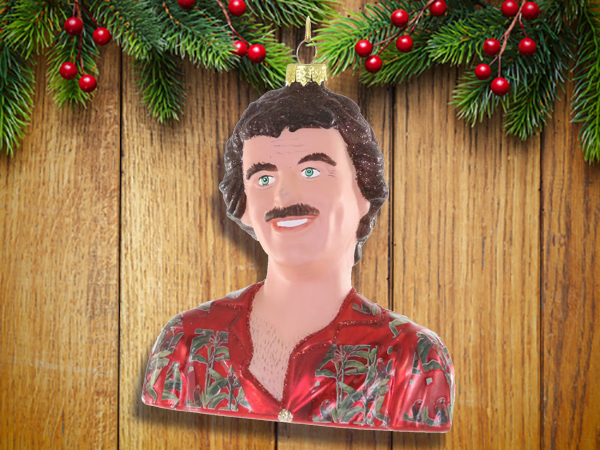I liked a lot of this stuff although the "Tom Selleck" orniment gave me pause...Different stroke for different folks I suppose. Although I really liked the "Casio Watch " it was seriously Retro.
I shamelessly clipped this from "Art of Manliness"
Stocking stuffers often get overlooked in the rush to see the bigger gifts Santa’s left (be sure to check out our ideas for those). But they’re one of my favorite parts of Christmas. There’s something so fun about little gifts small enough to be stuffed in a giant sock. Yet once a man ages out of the novelty toys of his youth, it can be hard to know how to fill his stocking with things that are both neat and useful. For that reason, we’ve created this guide that includes 50 stocking stuffers a father, husband, or brother will find both practical and delightful. While every stocking should have one or two just-for-fun items, too many stocking stuffers are bits of junk that get thrown in a desk drawer, and then, once the feeling of guilt wears off, put in a trash can or tag sale. So the things we’ve chosen are those a man will enjoy using the moment he pulls them from his stocking and for a long time afterwards.
Pocket Knife

Every man should carry a pocket knife. Huckberry carries a number of nice pocket knives like the Leatherman Skeletool.
Pocket Ref
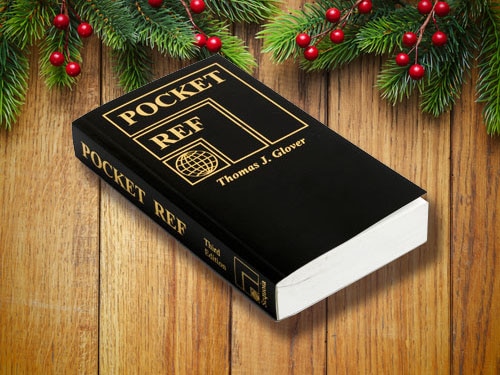
I love a good reference book and my favorite by far is the Pocket Ref, 4th Edition by Thomas J. Glover. This small, black book is crammed with just about every piece of information a man might want to know. Want to know about different lumber types? How about how to tie the fifty most common knots? Need a formula to determine the area of an oblique triangle? It’s all there in the Pocket Ref Guide and much, much more. Sure, you can find this info online these days, but this guide serves as a great book to have by the toilet so you can thumb through it while taking care of business.
Camp Snap Screen-Free Digital Camera
Remember when taking pictures meant you actually had to wait to see them? The Camp Snap brings that back. It’s a simple, screen-free digital camera that fits in your pocket, takes about 500 shots on a single charge, and stores a couple thousand total. No screen to stare at, no temptation to edit or post. Just point and click. You’ll have to wait to see the pics after you get home.
IronMind Captains of Crush Hand Gripper
The Captains of Crush grippers are the gold standard for building serious grip strength. Made from aircraft-grade aluminum and precision-machined steel springs, they feel like something you’d find in a blacksmith’s gym bag. They come in eleven different resistance levels. Even the lighter models will humble you fast. But with consistent use, they’ll toughen your hands, strengthen your forearms, and make every handshake feel like a statement. They’re small enough to keep on your desk or toss in a gym bag, and they’ll last a lifetime.
Casio A158WA Series Watch
The Casio A158WA is proof that style doesn’t have to be expensive. For under thirty bucks, you get a stainless-steel throwback that looks like it was plucked straight off your dad’s wrist in 1985. It’s light, reliable, and has just enough retro charm to stand out without trying too hard. You can wear it mowing the lawn or with a suit — either way, it somehow works. I own watches that cost twenty times more, but this one gets a surprising amount of time in my rotation. Simple, timeless, and indestructible — the A158WA is the best cheap watch you’ll ever actually love wearing.
Nose/Ear Hair Trimmer

Growing little sprouts from our nostrils and ears is just part of the natural life cycle of human males. While that hair growth can’t and shouldn’t be totally eradicated, it can easily be managed. Despite a number of trimming options, by far the best is the electric trimmer. They’re easy to use, get the job done fast, and don’t have any of the pinching or yanking of the other options.
Working Hands Cream
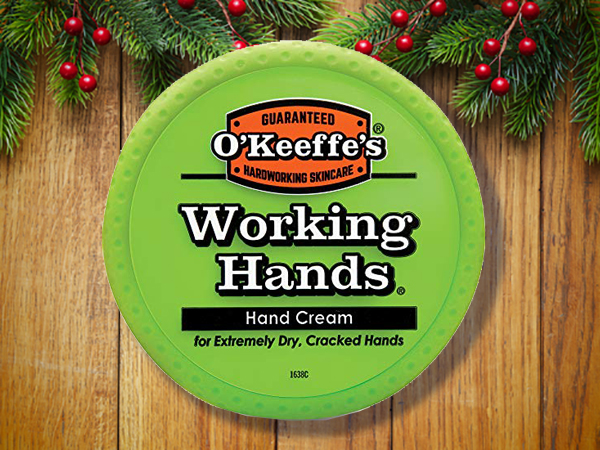
After a long day of house projects, a hard session of weightlifting, or a few hours spent on a woodworking project, even the toughest man’s hands need moisturizing relief. Working Hands is made for especially dry and cracked paws and will help heal and repair any damage inflicted from manly labors.
Khlip Ultimate Clipper

You may never have thought much about your nail clipper, but maybe you should. The Khlip makes for the ultimate upgrade. Superior ergonomics, clean-cutting blades, and a built-in cavity to hold the clippings make this the world’s best toenail tamer.
Huckberry Beanie

A Japanese-made beanie that blocks out the cold and keeps you stylish in the process. It’s also durable as heck. Include it in your loved one’s stocking this year, and he’ll be chomping at the bit to go outside and snowshoe or split some wood for the fireplace.
Sportsman Cologne

Sportsman Cologne adds a splash of adventure to your day. Handcrafted in small batches in Austin, Texas, this rugged scent features notes of leather, musk, flint stone, red clay, and pine. This has been Brett’s go-to cologne for fall and winter for several years.
Atech 5-in-1 AirTag Multi-Tool
Quit using your house key to hack open Amazon boxes. This compact Atech tool clips to your keyring, holds your AirTag, and actually gets the job done. It’s got a box opener, nail puller, 10mm wrench, and a couple of other tricks — all in solid metal. Small, useful, and way better than ruining your keys.
Bellroy Hide & Seek Wallet
The Hide & Seek Wallet is a natural starting point for those looking to slim their wallet. It’s conventional, yet loaded with hidden features and compartments that will Houdini away your extra bulk. Cut from premium vegetable tanned cow leather, it’ll protect your bills and plastic and photo of your sweetheart for years to come. This version of the Hide & Seek sports an RFID-blocking upgrade that protects your personal information contained in RFID enabled identification cards, passports and smart cards.
J. L. Lawson Decision Coin
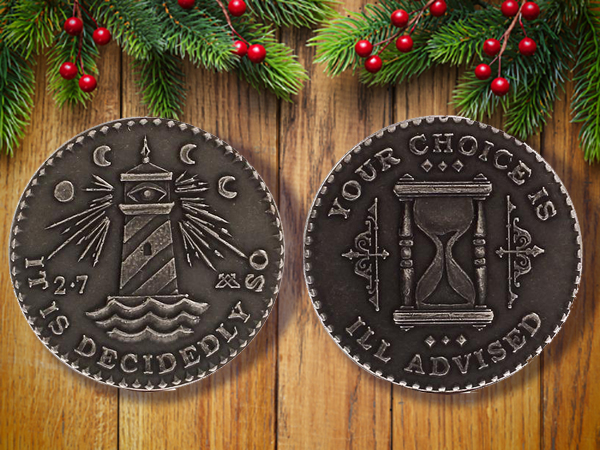
Minted from solid metal, the decision coin is a far more fun way to make coin flip decisions. Beyond that, it can be kept in a wallet as a reminder of the role that fate plays in all of our lives.
Survival Kit in a Sardine Can
This air-tight, waterproof, crushproof sardine can is packed with 25 survival items, including a fishhook, signal mirror, fire starter cube, and first aid supplies. Now, because of the variety and quality of the items in the can, this is far more of a novelty item than an actual survival kit. But it’s pretty cheap and a lot of fun; every stocking needs at least one item that’s simply designed to delight and act as a conversation piece. This fits the bill nicely.
Shaving Cream
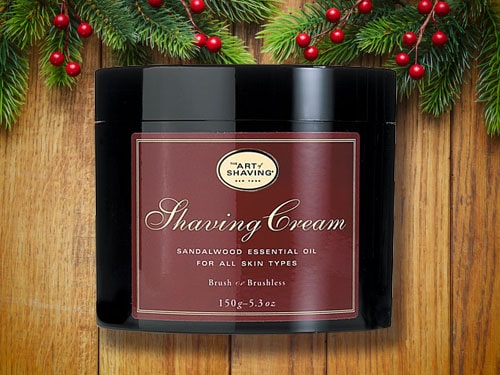
Most men lather up using some green goop from a can. These mass-produced shaving creams smell like you should be cleaning the floor with them. Share the pleasure of shaving with natural shaving creams and soaps with manly scents like almond or sandalwood. They cost more than the drugstore variety, but last far longer. My personal favorite is the sandalwood-scented shaving cream from Art of Shaving.
Firestarter and Striker

Knowing how to start a fire in a variety of ways is manly. The Firestarter and Striker tool set from Rill Simple Tools will make sure you’re always prepared to start a fire in a wilderness survival situation. The aluminum striker ignites magnesium in all conditions, regardless of wind, rain, snow, or temperature.
Varsity Disposable Fountain Pens
I love writing with a fountain pen. It makes writing even a lowly grocery list feel like a dignified affair. Unfortunately, a decent fountain pen can cost upwards of $50. If you want the fountain pen experience without the cost (and worry of losing an expensive pen) check out Varsity disposable fountain pens from Pilot. A 3-pack costs only $8 and writes almost as smoothly as more expensive fountain pens. These make a great stocking stuffer for a man who’s been curious about fountain pens, but hasn’t had the dough to try out an expensive one.
Davek Solo Umbrella
Most umbrellas are disposable. The Davek Solo isn’t.
Built from high-grade steel, fiberglass, and aluminum, its patented wind-combat frame shrugs off gusts that would leave a drugstore umbrella in the gutter. The carbon-reinforced ribs flex without snapping, and the water-repellent microweave canopy sheds rain like waxed canvas. This bad boy will protect you from the elements for years to come.
Zippo Pocket Handwarmer
This handsome handwarmer from Zippo makes the perfect stocking stuffer for the man who spends a lot of time in the freezing cold. My dad would have loved this in his game warden days on those cold mornings checking duck hunters.
Tactical Flashlight
Besides helping you find your car keys in a dark parking lot when you accidentally drop them, a small tactical flashlight can also serve as a useful self-defense tool. Shine the bright light from the tactical flashlight in a would-be attacker’s eyes to temporarily blind him and give yourself enough time to run or counter-attack. High quality tactical flashlights can cost well over $100. For most folks, that’s probably too much for a stocking stuffer. At about $40, the Streamlight 88301 Protac Tactical flashlight puts itself on the potential stocking stuffer bubble. While it doesn’t emit 500 lumens like its more expensive cousins, the 88301 does offer enough light output (180 lumens) to blind an attacker momentarily.
Hitch Hair Clay

If you’re looking for a hair product that provides hold, while maintaining a natural look, pick up a jar (or two of Hitch All Day Clay). Besides giving you a great coif, it has a clean fragrance with notes of bergamot, vetiver and sandalwood that goes well with anything.
Everyday Carry Items

According to the Every-Day Carry website, “Everyday Carry, or EDC, generally refers to small items or gadgets worn, carried, or made available in pockets, holsters, or bags on a daily basis to manage common tasks or for use in unexpected situations or emergencies. In a broader sense, it is a lifestyle, discipline, or philosophy of preparedness.” If you know a guy who ascribes to the EDC philosophy, nothing will delight him more than seeing some cool new pocket-sized things in his stocking. We’ve already covered pocket knives, flashlights, and handkerchiefs, but there are many more handy and neat things available.
Blackwing Pencils

These aren’t the standard yellow #2 pencils that you grew to hate during middle school. Just as fountain pens are a step up from the leaky ballpoints you buy in bulk, these Blackwing pencils are an upgrade over that old Ticonderoga. Made with California cedar wood and high-quality Japanese graphite, they deliver a surprisingly smooth, pencil-paradigm-changing writing experience. There’s a reason these iconic pencils have had a cult following since the 1930s. Be sure to grab the two-step sharpener as well.
SABANI 35,000mAh Portable Charger
The SABANI Power Bank packs a massive 35,000mAh battery — enough juice to charge your phone multiple times — yet it’s about the size of an iPhone. It’s got four built-in cables (Lightning, USB-C, USB-A, and Micro) plus three extra ports, so you can charge up to six devices at once without digging through a tangled mess of cords. Great for keeping your devices charged while you’re on a backpacking trip.
BioLite HeadLamp
A headlamp’s one of those tools you don’t think much about until you really need it. The BioLite 300 fixes the usual annoyances — dead batteries, accidental power-ons, and clunky weight. It’s USB-rechargeable, locks so it won’t turn on in your pack, and weighs just 50 grams. The battery sits neatly in the back of the moisture-wicking band, so it’s comfortable enough to forget you’re wearing it.
Drugstore Cologne
We wrote about six forgotten and manly drugstore colognes and aftershaves in 2012. It was a big hit. Cheap drugstore cologne was a staple in my dad’s stocking growing up, and I remember getting my first bottle of Brute in my stocking when I was twelve. Any of the old drugstore standbys make a great stocking stuffer gift. You can’t go wrong with Old Spice.
Instant Read Thermometer

Every backyard barbecuer needs a good meat thermometer. The usual variety, though, can be sort of fickle to use. You never know if you’ve waited long enough, or even how accurate it is since the needles tend to move a bit. With an instant read version, you don’t have to worry about that at all. Stick it in, and a couple seconds later you have an accurate reading. Can also be used with baked goods, homebrewed beer, and other foodstuffs that require precise temperature readings.
Analog Alarm Clock

Give the gift of better sleep! Most folks’ smartphones are in their rooms with them come bedtime. Whether diddling around and staying up too late (and sacrificing sleep) or using its alarm to wake you up, your phone ends up being the last thing you see at night and the first thing you see in the morning. But plenty of research — both anecdotal and scientific — has shown that getting your phone out of your room makes for improved sleeping, waking, and mental and physical health. When you give the gift of a “throwback” alarm clock, you give the gift of better well-being.
Pocket Notebooks

We’ve extolled the benefits of the pocket notebook numerous times — they’re so handy for writing down ideas, to-do tasks, or just capturing your bored scribbling. There are a variety of great pocket notebooks out there. Field Notes are a classic Made in America brand that have a nice vintage look to them. Huckberry has a series of Field Notes that pay homage to American National Parks. They’ve got a Rite in the Rain are cool because, well, you can write in them in the rain without losing your world-changing idea.
Snake River Farms Wagyu Beef Sticks
Made from 100% American-raised Wagyu, these beef sticks are a long way from gas station jerky. Snake River Farms — a family-run outfit that helped pioneer American Wagyu — blends Japanese bloodlines with American cattle to create that rich, buttery flavor and perfect snap.
No artificial junk, just clean protein you can toss in your pack or desk drawer. Great for hikes, road trips, or the stretch between lunch and dinner when you need something that actually tastes like real beef.
Original Arbuckles’ Ariosa Blend Coffee
Getting a coffee-lover a bag of beans is a no-brainer. But which should you choose? Instead of grabbing a bag from Starbucks on Christmas Eve, try the Ariosa blend from the Arbuckles’ coffee company. Touted as the “Original Cowboy Coffee,” and the “Coffee That Won the West,” John and Charles Arbuckle first made their coffee way back in 1864, pioneering the practice of selling pre-roasted beans and putting them in 1lb sacks. Packages come with a peppermint stick, just as they did over a century ago.
Old Fashioned Chewing Gum
Black Jack gum was first made by Thomas Adams all the way back in 1884. Made with aniseed, it was the first flavored gum made in the US and also the first gum to be offered in stick form. Adams’ company, American Chicle Co., then acquired Beeman’s in 1898 from its inventor, Edward E. Beeman. Beeman had incorporated pepsin in his recipe, a digestive enzyme, and Beeman’s became incredibly popular among pilots as an aid in both popping their ears and an antacid to settle their stomach acid during flight. Clove was another zippy flavor added by the company later on. These classic chewing gums were discontinued in the 70s and then brought back by Cadbury Adams and now make a great stocking stuffer for the man who wants to taste what Gramps was chomping on while playing stickball. Look for these gums at speciality candy stores.
David Protein Bar
The macros on the David Protein bare are impressive: 150 calories, 28 grams of protein, and zero sugar. They only have 2 grams of fiber, but they’re surprisingly filling. The result is a perfect 1.0 PDCAAS score, meaning it delivers all the amino acids your body needs. My favorite flavor is the Peanubutter Chocolate.
Huckberry Weekender Sunglasses

An all day, everyday pair of sunglasses that doesn’t break the bank. Lightweight but with a hardy construction, polarized lenses, and crucial hinge protection (which is where sunglasses always fail when/if they take a tumble), these can truly be taken anywhere. While a nice pair of shades makes for a good under-the-tree gift, everyone needs a pair or two that they don’t have to worry too much about.
Uncle John’s Truth, Trivia, and the Pursuit of Factiness
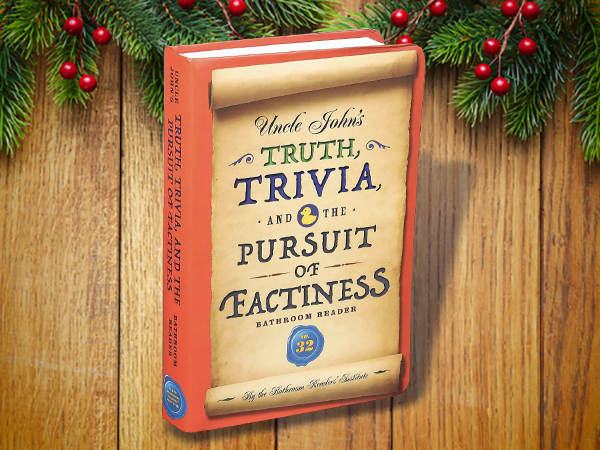
Every bathroom needs a bathroom reader — a handy little book that can be perused a few minutes at a time while doing your business. The classic in the genre is the Uncle John’s series, which is now in its 32nd edition. With short tidbits of interesting facts and longer tales of daring and misdeed, there’s always something fascinating to be found in its pages, no matter how long the visit.
Wythe New York Camp Socks
The kind of socks you want to live in all winter. Knit in North Carolina from recycled cotton, these Wythe Camp Socks are soft, sturdy, and built for both the couch and the woodpile. The jacquard-knit evergreen pattern gives them just enough seasonal flair without going full ugly-sweater. Warm, durable, and quietly festive — the perfect stocking stuffer for anyone with cold feet.
BFWood Clothes Brush
A good clothes brush is one of those old-school tools that every man should own but few actually do. This one from BF Wood makes a great case for bringing the habit back.
Crafted from solid beech wood and fitted with pure boar bristles, it hits that perfect middle ground — soft enough not to damage delicate fabrics like wool or cashmere, stiff enough to sweep away lint, fuzz, and dust. A quick pass over a jacket or sweater before heading out the door will leave it looking sharper and lasting longer.
Roark’s Cove Solid Cologne
Cologne, without the glass bottle or the splashy mess. Fulton & Roark’s solid fragrance is compact, travel-ready, and built for men who actually move around. Just rub some on you. This fragrance sits in the amber-woody-earthy family — bright at the top with bergamot, cloudberry, and pink pepper, grounded by oak chips, tonka bean, and cedarwood. The result is warm, clean, and quietly masculine; it smells like a hike through pine and sun-warmed rock after a fresh shave.
Lock Pick Training Kit

At AoM, we’re aficionados of the fine art of lock picking. This clear lock pick training set you can fine tune your lock picking craft by seeing how the tumblers and springs move as you rake your way to opening the lock. Set comes with clear training lock, tension wrench, and four picks.
Spy Coin
It looks like spare change, but it isn’t. This clever little gadget uses real U.S. Kennedy half-dollars that snap apart to hide a micro-SD inside—clean, simple, and delightfully sneaky. Stick a card in there between shoots, drop it in a gear case, and nobody will guess your film negatives (or files) are riding shotgun in a coin.
Ammo

Ammo is kind of expensive and you want plenty of it on hand for those impromptu trips to the gun range. Make sure you get the right kind of ammo, though. It’d be a bummer to get boxes of 9mm bullets when your gun is a .38 special. I’m hoping Santa drops a few boxes of shotgun shells in my stocking this year.
Harmonica
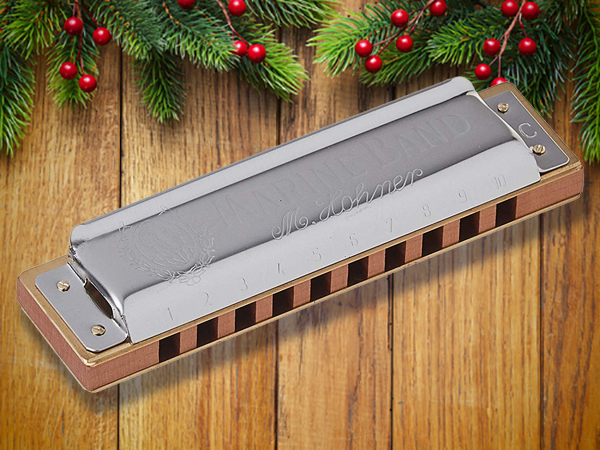
The tin sandwich has a long and rich history, especially in the American South and West. The beauty of this instrument is threefold: it’s relatively inexpensive (even for a quality model), it’s small and portable (easily fitting into nearly any pocket), and it’s one of the easiest instruments to learn (to the point of playing recognizable tunes). Get one for everyone in the family and have some Christmas singalong time right then and there.
Tom Selleck Ornament
Your tree could use a little more mustache. This hand-painted glass ornament from Cody Foster & Co. captures Tom Selleck in all his 1980s glory — Hawaiian shirt, chest hair, and the most famous ’stache in television history. It’s equal parts classy and ridiculous, which is exactly what makes it perfect. Hang him up and let a little Magnum P.I. energy patrol your Christmas tree.
Wall Mount Bottle Opener
A classic wall mount bottle opener placed right next to the fridge eliminates the hassle of twisting off a bottle cap, plus it makes opening a cold one a bit more enjoyable.
Duncan Yo-Yo

Even as a grown man, I enjoy getting a kid’s toy in my stocking. It’s fun to have something to play with on Christmas morning and it just makes me feel like a boy again. You can’t go wrong with stuffing a stocking with an Imperial yo-yo from Duncan Yo-Yos. Besides giving a dad or uncle a chance to show off some cool tricks to the kiddos on Christmas morning, throwing the yo-yo is a surprisingly great activity for quieting the mind when you’re sorting through a problem.
Estwing Hammer

Every man should have a high-quality hammer in his garage or tool chest. It’s not always easy to throw down $20 on a hammer when there’s a $7 version right next to it at the hardware store. It’s worth the extra bucks though, making it a great stocking stuffer. Practical, but also just kinda fun. Bonus: Estwing tools are made right here in the USA.
Tins of Shoe Polish

I don’t know about you, but I always seem to be out of shoe polish whenever I actually need it. I’ll make a mental note to pick some up on my next trip to the grocery store, and of course, I’ll go to the store and forget to buy some. The occasion will arise again when I need to shine my shoes and the vicious cycle repeats itself. It’d be nice just to have copious amounts of shoe polish tins in my shoe shine box so I’d never have to worry about buying a can ever again. I’m pretty sure if Santa left two or three cans in my stocking each year my wish would be a reality. At $4 a tin, it’s the perfect stocking stuffer.
Universal Socket

This Universal Socket is the ultimate tool for the DIY enthusiast. Its versatile design adjusts to grip hex nuts, hooks, and other various shapes, making it the perfect stocking stuffer. Crafted for strength and durability, it’s compatible with any drill and nuts ranging from 7mm-19mm. A compact powerhouse, it’s bound to become an essential in any man’s toolbox.
Knife Sharpening Kit

If you’re going to put a pocket knife in a man’s stocking, he’ll also need a good sharpening stone to keep his blade in tiptop shape. You might also include a slip of paper with a link to our guide on how to sharpen a pocket knife. Smith’s Sharpening Kit has everything a man needs to start sharpening his knife: a medium-grained stone, a fine-grained stone, and oil.
Balsa Wood Airplanes

Another fun toy to give a man in his stocking stuffer is a balsa wood airplane. They’re easy to put together and you’ll have a blast tossing them around the house. The Duluth Trading Co. is offering a squadron of 12 made by a company that’s been making the planes here in America for decades.


